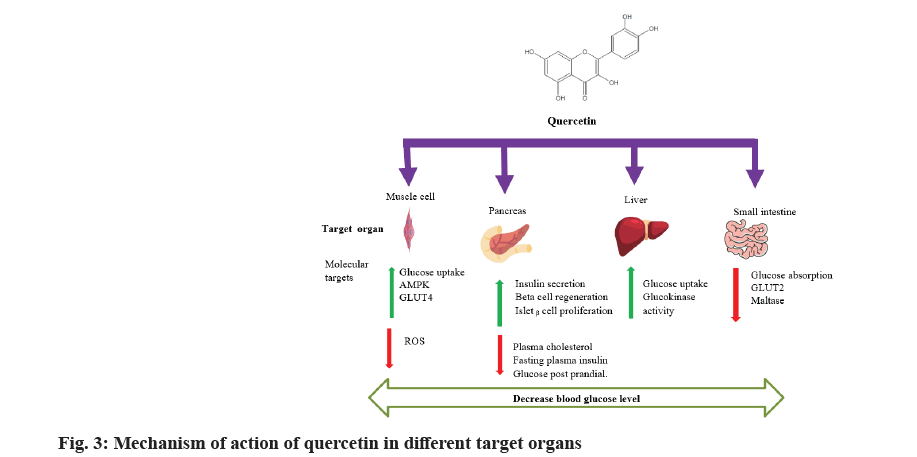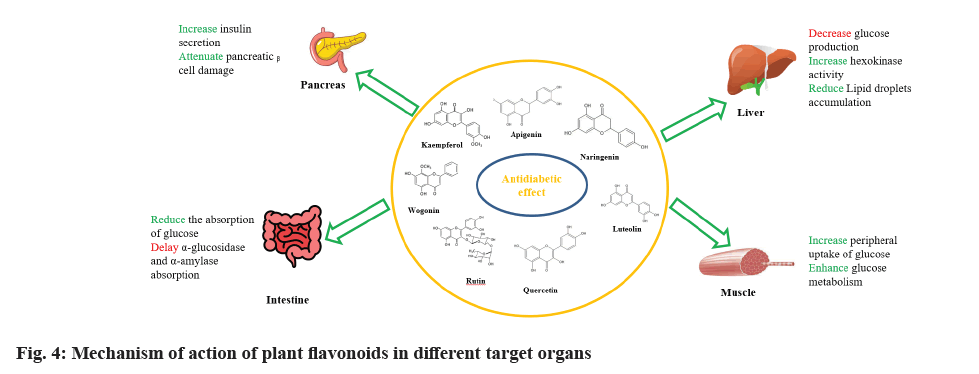<div class="post-author">
<p><strong>B. Das and P. Saha<a href="#corr"><sup>*</sup></a></strong></p>
<p>Department of Pharmaceutical Chemistry, Guru Nanak Institute of Pharmaceutical Science and Technology,
Kolkata, West Bengal 700114, India</p>
</div>
<dl class="dl-horizontal">
<dt>*Corresponding Author:</dt>
<dd>P. Saha<a name="corr" id="corr"></a> <br />
Department of Pharmaceutical Chemistry, Guru Nanak Institute of Pharmaceutical Science and Technology,
Kolkata, West Bengal 700114, India <strong><br />
E-mail:</strong> prerona.saha@gnipst.ac.in</dd>
</dl>
<div class="well well-sm">
<table class="table">
<tbody>
<tr>
<td width="50%">Date of Received</td>
<td>06 July 2023</td>
</tr>
<tr>
<td>Date of Revision</td>
<td>08 June 2024</td>
</tr>
<tr>
<td>Date of Acceptance</td>
<td>17 June 2024</td>
</tr>
<tr>
<td>Indian J Pharm Sci 2024;86(3):805-817</td>
<td> </td>
</tr>
</tbody>
</table>
</div>
<p>This is an open access article distributed under the terms of the Creative
Commons Attribution-NonCommercial-ShareAlike 3.0 License, which
allows others to remix, tweak, and build upon the work non-commercially,
as long as the author is credited and the new creations are licensed under
the identical terms</p>
Abstract
Diabetes mellitus is a serious global health problem characterised by hyperglycemia due to an absolute or relative deficiency of insulin or insulin resistance. The antidiabetic potential of different natural products has been studied for a long time. Flavonoids are found in vegetables, fruits and fungi and exhibit a wide range of biological activities including anti-inflammatory, antioxidant, nephroprotective, hepatoprotective and antidiabetic. Over 5000 flavonoids are distributed in the plant kingdom and have been isolated and identified. Many medicinal plants are a common part of people's daily diet in West Bengal. Many of these medicinal plants belong to the Acanthaceae family, which contains approximately 70 genera and 340 species in India and includes many phytochemical constituents like glycosides, flavonoids, phenolic compounds and terpenoids. This review explores the antidiabetic potential of natural flavonoids obtained from selected edible plants of the Acanthaceae family that are commonly available and consumed in West Bengal. Therefore, based on this information, nutritional recommendations can be made for the prediabetic population who may benefit from prioritising this in their daily diet. However, further studies are required to complete the profiling of flavonoids in more Acanthaceae family plants with antidiabetic potential. Different medicinal plants of the Fabaceae, Acanthaceae and Amaranthaceae families comprise several flavonoids that are also responsible for antidiabetic activity.
Keywords
Diabetes mellitus, hyperglycemia, antidiabetic potential, flavonoids, plants, Acanthaceae
Diabetes is a serious metabolic disease caused by uncontrollable blood glucose levels that affects most of the population worldwide. This will cause a burden on society that can affect approximately 439 million adults by 2030. Effective control of blood glucose levels is the key to preventing diabetic complications in both type I and type II diabetic patients. Chronic hyperglycemia is also responsible for other complications related to heart disease, nerve and vision problems, disturbance of mental health and many other difficulties[1].
Plants are an excellent source of alternative medicine for various diseases and disease-related complications. It has already been reported that worldwide 25 % of drugs are plant-derived and according to the World Health Organization (WHO), 21 000 plants are used for therapeutic purposes[1]. Approximately 80 % of India’s rural population is familiar with using different herbal medicines to treat various diseases.
The interest of people in herbal medicines is increasing daily because of their fewer side effects compared with synthesised drugs[2]. Leaf materials (37 %), followed by seeds (16 %) and fruits (14 %) were mostly used for the treatment of diabetes[3]. Acanthaceae is one of the most significant family widely used in traditional medicine, exhibiting anti-diabetic properties and other therapeutic activities[4]. At the same time, many common edible plants in West Bengal exhibit anti-diabetic properties and are included in the Acanthaceae family. This review aimed to provide a better understanding of the anti-diabetic potential of edible plants of the Acanthaceae family in West Bengal, with special reference to the mechanisms of action of different flavonoids.
Diabetes Mellitus and Flavonoids
Diabetic mellitus (fig. 1), is a major concern in the world, with a huge increase over the years, especially in countries of low to middle-income status[5]. Until now, insulin and anti-diabetic drugs have been the main therapies to treat diabetics[6]. However, most of the synthetic anti-diabetic drugs showed some unwanted and unavoidable side effects, as mentioned in Table 1[7-18].
| Antidiabetic class | Antidiabetic drug | Risk factors | References |
|---|---|---|---|
| α-glucosidase inhibitors | Acarbose, miglitol, voglibose | Gastrointestinal track side-effect, liver function hampered | [45-47] |
| Biguanides | Metformin | Gastrointestinal side effects, risk of lactic acidosis, chronic liver disease, congestive heart failure | [48-50] |
| Sulfonylureas | Glicazide, glibenclamide, glimepiride | Hypoglycemia, weight gain | [51,52] |
| Meglitinides | Nateglinide, repaglinide, mitiglinide | Weight gain, hypoglycemia | [45] |
| GLP-1 receptor agonists | Exenatide, liraglutide | Gastrointestinal adverse events | [45,53] |
| DPP-4 inhibitors | Sitagliptin, saxagliptin, alogliptin | Gastrointestinal side-effects | [45] |
| Thiazolidinediones | Pioglitazone, rosiglitazone | Weight gain, edema, heart failure | [54] |
| SGLT2 inhibitors | Dapagliflozin, canagliflozin | Genitourinary infections | [55] |
| Exogenous insulin | Rapid acting, short acting, intermediate acting, long acting | Weight gain, hypoglycemia by subcutaneous route injection | [46,56] |
Table 1: Anti-Diabetic Drugs with their Risk Factors
Therefore, an alternative approach is required to cure the disease with better potency and efficacy and fewer side effects. Herbal plants have been used for the management of various diseases since ancient times and are major parts of our daily diet. Plant drugs or herbal formulations are considered less toxic, have fewer side effects and are cheaper than synthetic drugs[19].
Flavonoids are a group of hydroxylated phenolic substances obtained from plant material and show different pharmacological effects[20]. The basic structure of flavonoids (fig. 2), is a 15-carbon skeleton consisting of a fused A and C ring linked to a benzene ring (ring B). The flavonoids are classified according to the side group position and substitutions such as flavones (e.g. diosmin, apigenin, tangeretin, wogonin, chrysin and luteolin), flavonols (e.g. quercetin, kaempferol, myricetin, rutin, isorhamnetin, morin and fisetin), flavanones (e.g. eriodictyol, hesperetin, baicalein and naringenin), isoflavones (e.g. Genistein, Daidzein) and anthocyanins (e.g. cyanide, delphinidin, pelargonidin)[21,22].
Anti-Diabetic Potential of Edible Plants of Acanthaceae Family
Acanthaceae family consists most of the herbs or shrubs, with a few trees or vines. It is a widely distributed family, especially found in tropical and subtropical areas. These plants include approximately 250 genera and nearly 2500 species; with around 70 genera and 340 species found in India. It has been reported that about 32 genera and 81 species are from West Bengal. This is a large family in the plant kingdom, with numerous traditional uses, including potential anti-diabetic properties. Different edible plants in West Bengal belonging to the Acanthaceae family contain various bioactive compounds, known as secondary metabolites. Among these, flavonoids are the most significant phytoconstituents responsible for the antidiabetic activity[23,24].
Andrographis paniculata (A. paniculata) (Burm.f.) Nees:
A. paniculata (Synonym: Justicia paniculata) is native to India, Bangladesh, China, Hong Kong, Pakistan, The Philippines, Malaysia, Indonesia and Taiwan[25]. It is locally called ‘Kalmegh’ in West Bengal.
Antidiabetic activity: This plant has an extremely bitter taste. A. paniculata extract possesses hyperglycemia effects in alloxan-induced diabetic rats by inhibiting β-cell dysfunction[26]. Ethanolic and hot water extracts of this plant effectively decrease the blood sugar level in alloxan induced rats[27]. The mechanism behind this effect may regulate glucose uptake and insulin signalling molecules restored in the liver and reduce serum lipid levels. A. paniculata effectively lowers blood glucose levels, similar to metformin (a popular marketed drug used to treat diabetes). This edible plant works against diabetics through various mechanisms, including enhancement of glucose uptake and oxidation in the peripheral tissues, inhibiting α-glucosidase, development of insulin sensitivity and controlling lipid metabolism[28]. The extract of A. paniculata leaves shows an inhibitory effect of α-amylase and α-glucosidase [29].
Other activities: This medicinal herb is also used to treat and control liver function, anti-cancer properties, detoxification, bowel complications in children, anti-atherosclerosis, colic pain, cooling and relieving internal heat, inflammation and pain relief, anti-infective properties, antioxidant effects, common cold and cough treatment, immunomodulation, upper respiratory tract infection, and many more[25].
Acanthus ilicifolius L.:
This plant (Synonym: Dilivaria ilicifolia Juss) is locally known as ‘Kanta Jhuri’ (Bengali)[30]. Krishna Saraiyaka (Blue-flowered Katasaraiyaa) in Ayurveda and Kollimulli in Siddha[31].
Antidiabetic activity: Ethanolic extracts of the Acanthus ilicifolius root (200 mg/kg and 400 mg/kg) showed antidiabetic activity against alloxan-induced hyperglycaemia and exhibited enhancement of regeneration of pancreatic β cells, which is comparable to glibenclamide (10 mg/kg) [20]. The main cause of this antidiabetic activity of the extract may be β cell regeneration and subsequent destruction by alloxan[32].
Other activities: This plant exerts a wide range of therapeutic activities, i.e., asthma, leucorrhoea, respiratory trouble, diuretics, cough relief, paralysis, temporary senselessness of organs, etc. [31].
Justicia gendarussa (J. gendarussa) Burm. f.:
J. gendarussa (Synonym: Gendarussa vulgaris Nees.), commonly known as J. gendarussa Burm. The Bengali name ‘Bisallakaroni’ is quoted in the Ramayana[33]. It is generally distributed widely in India, native to China, Andaman, Sri Lanka and Malaysia[34].
Antidiabetic activity: Methanolic leaf extract of J. gendarussa affects alloxan and glucose-induced diabetic mice, which has the potential to lower fasting glucose levels in the blood. In alloxan induced mice, the leaf extract exhibited extreme blood glucose level reduction as metformin in the same duration (12 h). Here, the antihyperglycemic activity of this leaf extract was dose dependent[35].
Other activities: This plant also exhibits other tremendous pharmacological activities, including cough, stop bleeding, digestive trouble, fresh leaves-edema, arthritis, fever, muscle pain, respiratory disorders, headache, hemiplegia, earache, leaves infusion in facial paralysis, cephalalgia, hemiplegia, febrifuge, diaphoretic, emmenagogue, emetic and many more[31,34].
Justicia adhatoda (J. adhatoda) L.:
J. adhatoda L. (Synonym: Adhatoda vasica Nees.) is a well-known, evergreen, small shrub named ‘Bakas’ (Bengali) in West Bengal and known in Ayurveda as Vaasaka, Vaasikaa vrisha, Aataruushaka and Arusaa in Unani[31]. This shrub grows throughout Bengal, Punjab, upper and lower Myanmar, Sri Lanka, Manipur and southern China[36].
Antidiabetic activity: Ethanolic extracts of J. adhatoda L. (50 mg/kg and 100 mg/kg) decreased the blood glucose level after 3 to 6 d of treatment, where the ethanolic leaf extract of 100 mg/kg was more effective than glibenclamide (a standard antidiabetic drug). Ethanolic root and leaf extracts of J. adhatoda have diminished the sugar level in blood, urine and tissue lipids in alloxan diabetic rats and also affect serum insulin levels. The mechanism behind the antihyperglycemic action may involve insulin secretion from the pancreas, improvement of blood glucose transport and elevation of insulin levels in diabetic rats[37]. The ethanolic leaves and roots extract of J. adhatoda (100 mg/kg body weight) and the reference drug glibenclamide (5 mg/kg body weight) resulted in significant reductions in blood sugar levels in diabetic rats. The antidiabetic effect is also demonstrated when using silver nanoparticles (synthesized) with this plant extract[2].
Other activities: This plant has been used for more than 2000 y and different parts of this plant exhibit a wide range of pharmacological activities such as hypotensive properties, treatment of chronic cough and cold, expectorant effects, antispasmodic properties, asthma relief, uterotonic and abortifacient effects, smooth muscle relaxation, cardiac depressant, relief from menorrhagia, febrifuge properties and act as a bitter bronchodilator. The leaves have been reported to stimulate trypsin, exhibit antifungal activity against ringworm, assist in treating haemoptysis (fresh leaves), as well as dyspnoea (Ayurvedic Pharmacopoeia of India) and act as an expectorant according to the Indian Herbal Pharmacopoeia[2,31,38-40].
Hygrophila auriculata (H. auriculata) (Schumach.) Heine:
This plant [Synonym: Asteracantha longifolia (L.) Nees., Asteracantha auriculata Nees] is known in Ayurveda as Kokilaaksha, Kokilaakshi[31,41]. This herb is commonly known as “Kulekhara” or “Kuliakhara” in Bengali, “Marsh Barbel” in English, “Talmakhana” and “Kamtakalya” in Hindi[41,42]. It is generally distributed in tropical and subtropical regions of India[43].
Antidiabetic activity: The aqueous extracts of H. auriculata exhibit significant dose dependent hypoglycaemic activity. An in vivo study reveals that the aqueous extract of the whole plant in tolbutamide-induced diabetes enhanced the capacity to use external glucose load, which has a similar mechanism to sulphonylureas[44]. Aqueous leaf extract of this plant improves insulin secretion in alloxan-induced diabetics in male albino Wistar rats. Anti-diabetic activity is shown in water, methanol, ethanol and chloroform seed extracts of this plant by amylase and glucose diffusion inhibition and also in streptozotocin induced diabetic rats, however, methanol extract shows the most potent antidiabetic activity[2,45]. Hydroalcoholic extracts of H. auriculata with 100 mg/kg and 250 mg/kg body weight doses were treated within 3 w and exhibited a significant decrease in blood sugar level[2].
Other activities: This herb exhibits notable therapeutic potential as leaves-diuretic, spermatorrhoea, urinogenital tract disease, seedsdiuretic, edema, sexual vigor, arthritis, arrest abortion and cure diseases due to vitiated blood[42]. This plant also displays anti-inflammatory, hypotensive and spasmolytic activity[31,42].
Barleria lupulina Lindl.:
B. lupulina Lindl. is a herb or shrub, called ‘Kanta Bisallakarani’ (Bengali) in West Bengal[30,46]. A total of 300 bacteria species were globally reported, generally distributed in the mountains of the southern and western parts of India, all over Asia and most of the tropical countries.
Antidiabetic activity: The methanolic extract of the aerial parts of this plant shows blood glucose lowering potential in streptozotocin hyperglycemic rats. Here, a 15.35 % reduction in blood glucose level was seen for the extract of 300 mg/kg body weight at 12 h after administration, compared to 18.80 % for the same time interval at 10 mg/kg body weight for glibenclamide (standard drug). This plant extract acts the same as glibenclamide (an anti-diabetic drug)[47].
Phlogacanthus thyrsiformis (P. thyrsiformis) (Roxb. ex Hardw.) Mabb.:
P. thyrsiformis (Roxb. ex Hardw.) Mabb. is a quadrangular branchlet, evergreen shrub that reaches a height of about 2.4 m. This plant is known as Rambasak and Titaphul in West Bengal, Chuhai in Bihar, Titaaphul in Assam and is usually found in North Bengal, Bhutan, Bihar, the plains and hills of Assam and Bangladesh[31,49].
Antidiabetic activity: The plant extract of P. thyrsiformis significantly controls blood glucose levels in diabetic rats by reducing of fasting serum glucose. The ethyl acetate extract of P. thyrsiformis (Roxb. ex Hardw.) Mabb. leaves in diabetic rats show a considerable reduction in fasting serum glucose. The mechanism behind this glucose level reduction involves modifying the plasma insulin effect by regulating the insulin secretion from the pancreatic β cells [49].
Other activities: This plant reportedly exhibits therapeutic effects other than antidiabetic activities, such as treating cough, whooping cough, menorrhagia, fevers, spleen and liver diseases using different parts of the plant-the whole plant, fruits and leaves[50].
Thunbergia grandiflora (T. grandiflora) Roxb.:
T. grandiflora Roxb. (Synonym: Thunbergia alata Bojer ex Sims) has more than 100 species. It is a vigorous, long-lived (perennial), climbing plant.
Antidiabetic activity: Aqueous methanol leaf extract of T. grandiflora Roxb at a dose of 100 mg/ Kg body weight on diabetic rats with high blood glucose levels significantly reduces the blood glucose level by 25.6 % after 2 w and by 49.9 % after 4 w. In comparison, metformin (reference drug) decreases blood glucose levels by 44.5 % after 2 w and 67.1 % after 4 w.
Other activities: This plant has other significant pharmacological effects, such as antioxidant, poultice, antimicrobial activity, snake bite and hepatoprotective activities[51].
Anti-Diabetic Activity of Plant Flavonoids in the Edible Plants of Acanthaceae Family
More than 400 plant species have hypoglycaemic potential due to the presence of different secondary metabolites[52]. Among them, flavonoids are the most common bioactive component. It was reported that the phytochemical analysis of different plant extracts shows the presence of major chemical constituents such as flavonoids, steroids, tannins, etc. The existence of flavonoids in the plant can be responsible for its anti-diabetic activity[47]. Selected 8 edible plants of the Acanthaceae family in West Bengal with different flavonoid types that demonstrate anti-diabetic potential are listed in Table 2[53-59]. The plant extracts of different edible plant parts exhibited anti-diabetic activity, so different edible parts were also mentioned in Table 2, for individual plants.
Anti-Diabetic Mechanism of Flavonoids
The reduction of blood glucose levels occurs mainly through the enhancement of glucose uptake, inhibition of lipolysis, promotion of lipogenesis and promotion of glucose storage and utilization in the liver[21]. Table 2, shows the major flavonoids of Acanthaceae family plants in West Bengal with their different edible parts. Among the different classes of flavonoids, quercetin is the most extensively studied dietary flavonol and is found in most edible fruits, green vegetables, flowers and barks and from multiple sources. For the management of type 2 diabetes and the complications related to diabetes, quercetin can be the choice of nutraceutical. A widely prescribed anti-diabetic drug metformin exhibits a similar effect to quercetin. Quercetin has multiple target organs in the human body such as muscle cells, pancreas, liver and small intestine, as represented in fig. 3. Different classes of natural flavonoids which were obtained from the edible plants of West Bengal in the Acanthaceae family exhibit antidiabetic potential through the reported mechanism of action as illustrated in Table 3[21,60-64]. Different classes of natural flavonoids have different target organs in our body i.e., pancreas, intestine, liver and muscle, where they reduce blood sugar levels in our body. The study reveals the mechanism of action of the flavonoids, which play a major contribution in diabetic management as shown in below fig. 4.
| S No | Local name | Scientific name | Flavonoid | Edible Parts | Reference |
|---|---|---|---|---|---|
| 1 | Kalmegh | Andrographis paniculata (Burm.f.) Nees | 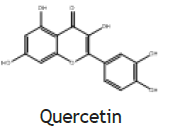 |
Leaves | [57,58] |
| Quercetin | |||||
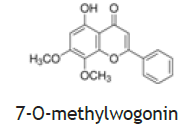 |
|||||
| 7-O-methylwogonin | |||||
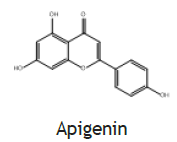 |
|||||
| Apigenin | |||||
| 2 | Kanta Jhuri | Acanthus ilicifolius L. | 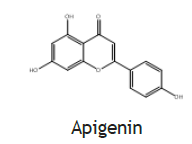 |
Leaves, stem, root | [59] |
| Apigenin | |||||
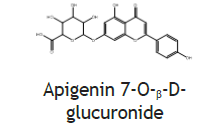 |
|||||
| Apigenin 7-O-ᵦ-D-glucuronide | |||||
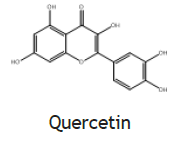 |
|||||
| Quercetin | |||||
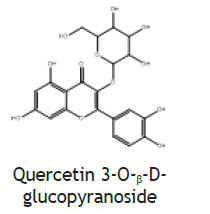 |
|||||
| Quercetin 3-O-ᵦ-D-glucopyranoside | |||||
| 3 | Bisallakaroni | Justicia gendarussa Burm.f. | 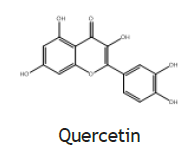 |
Leaves | [60,61] |
| Quercetin | |||||
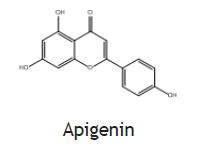 |
|||||
| Apigenin | |||||
| 4 | Basak | Justicia adhatoda L. | 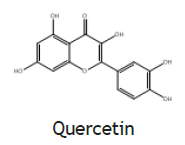 |
Leaves | [59,24,27] |
| Quercetin | |||||
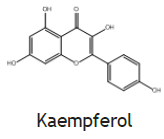 |
|||||
| Kaempferol | |||||
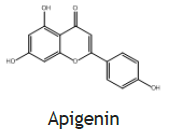 |
|||||
| Apigenin | |||||
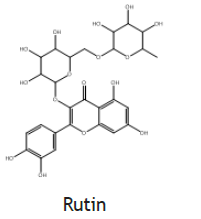 |
|||||
| Rutin | |||||
| 5 | Kulekhara | Hygrophila auriculata (Schumach.) Heine | 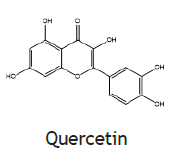 |
Leaves, flowers | [62,63] |
| Quercetin | |||||
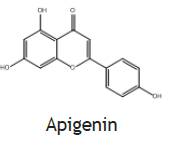 |
|||||
| Apigenin | |||||
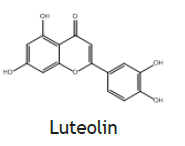 |
|||||
| Luteolin | |||||
| 6 | Kanta Bisallakarani | Barleria lupulina Lindl. | 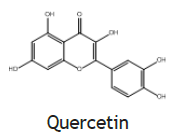 |
Leaves | [34,36] |
| Quercetin | |||||
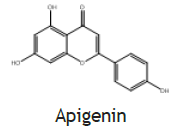 |
|||||
| Apigenin | |||||
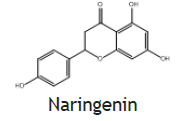 |
|||||
| Naringenin | |||||
| 7 | Nongmangkha | Phlogacanthus thyrsiformis (Roxb. ex Hardw.) Mabb. | 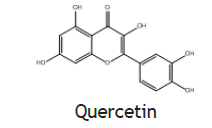 |
Leaves , fruits | [64] |
| Quercetin | |||||
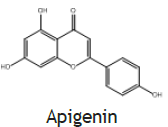 |
|||||
| Apigenin | |||||
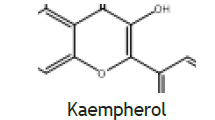 |
|||||
| Kaempherol | |||||
| 8 | Blue skyflower | Thunbergia grandiflora (Roxb. ex Rottl.) Roxb. | 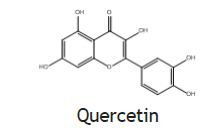 |
Leaves | [39] |
| Quercetin | |||||
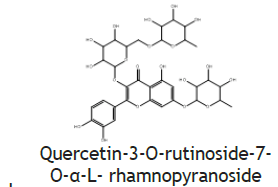 |
|||||
| Quercetin-3-O-rutinoside-7-O-α-L- rhamnopyranoside | |||||
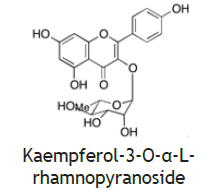 |
|||||
| Kaempferol-3-O-α-L-rhamnopyranoside | |||||
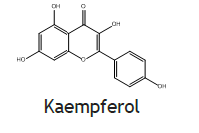 |
|||||
| Kaempferol |
Table 2: Anti-Diabetic Flavonoid of 8 Edible Plants of the Acanthaceae Family in West Bengal
| Flavonoid subclass | Name of flavonoid | Function of flavonoids | Mechanism of action |
|---|---|---|---|
| Flavonol | 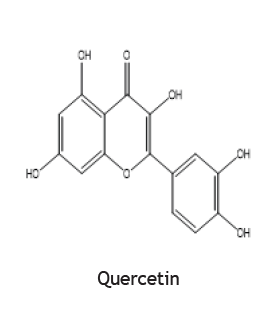 Quercetin |
Anti-hyperglycemic and hypolipemic effect | Inhibit insulin-dependent activation of PI3K |
| Inhibit GLUT2 which reduces the absorption of glucose in small intestine | |||
| Block the activity of tyrosine kinase Improve GLUT4 translocation through the activation of AMPK | |||
| Improve the recovery of cell proliferation | |||
| Improve glucose absorption Reduce lipid peroxidation | |||
| Reduce oxidative stress | |||
| Preserve beta cell mass | |||
| Protect beta cell | |||
| Promote glycogen synthesis | |||
| Inhibit advanced glycated end product formation | |||
| Flavonol | 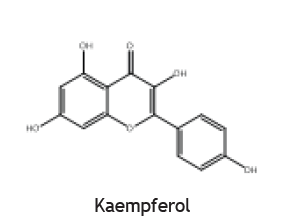 > > Kaempferol |
Anti-hyperglycmeic and hypolipemic effect | Reduce serum glucose level |
| Improve glucose uptake | |||
| Improve cAMP signalling and insulin synthesis and secretion | |||
| Protect beta cells | |||
| Inhibit alpha-amylase | |||
| Flavonol | 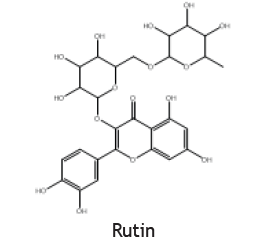 Rutin |
Anti-hyperglycmeic and hypolipemic effect | Increase serum level of HDL |
| Increase hexokinase activity in liver | |||
| Decrease G6Pase, PEPCK, glycogen phosphorylase | |||
| Reduce serum LDL, VLDL | |||
| Stimulate glucose uptake | |||
| Inhibit alpha- glucosidase | |||
| Reduce oxidative stress | |||
| Flavones | 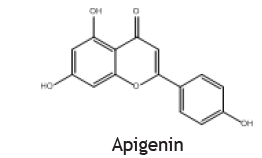 Apigenin |
Anti-hyperglycmeic effect | Reduce cellular antioxidants |
| Improve GLUT4 translocation which lower glucose level | |||
| Increase serum cholesterol | |||
| Protect beta cells | |||
| Flavanones | 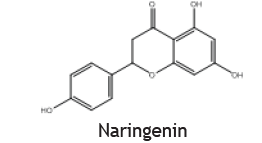 Naringenin |
Antihyperglycmeic and hypolipemic effect | Induce hypolipidemic activity |
| Activate AMPK pathway | |||
| Reduce membrane lipid peroxidation | |||
| Inhibit alpha-glucosidase | |||
| Flavones | 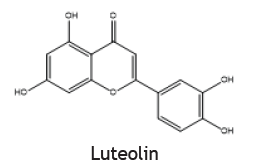 Luteolin |
Antihyperglycmeic and hypolipemic effect | Improve insulin secretion |
| Reduce apoptosis | |||
| Reduce cAMP response element binding protein | |||
| Flavones | 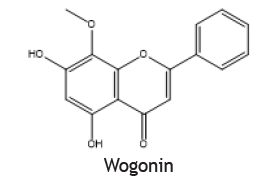 Wogonin |
Antihyperglycemic and hypolipemic effect | Reduce hyperglycemia and lipid droplets accumulation in the liver |
| Increase vascular permeability and the expression of cell adhesion molecule |
Table 3: Mechanism of Action of Flavonoids as Anti-Diabetic Effects
Discussion
Some selected Acanthaceae family plants show anti-diabetic properties, which are edible and commonly available in West Bengal. Management of disease with the herbal formulation is highly acceptable for its easy accessibility, fewer side effects and elimination of the hazardous pharmaceutical synthesis process. Moreover, day by day, the interest of people increases towards folk medicine. Some flavonoids have similar mechanisms of action as synthetic drugs that are normally available in the market. The most common flavonoid, quercetin, induces Adenosine Monophosphate-activated Protein Kinase (AMPK) activity in hepatocytes and inhibits the glucose 6 phosphatase. The well-known anti-diabetic drug metformin also acts through AMPK activation[60]. However, several mechanisms have been observed for different flavonoids. Flavonoids are the most common available secondary metabolites obtained from the plant kingdom. Aside from quercetin, a huge number of flavonoids and their derivatives also help to control blood glucose levels. In the selected plants, many of these flavonoids found to be present in the Acanthaceae family have promising anti-diabetic effects by improving glucose homeostasis, decreasing insulin resistance, increasing insulin sensitivity, glucose utilization and/or improving cell function and insulin action[61]. Quercetin and apigenin are almost common in all the listed selected plants mentioned in Table 2. It was observed that the study of the antidiabetic potential of different plants was determined by animal models such as alloxan-induced diabetic rats and mice, glucose-induced diabetic mice, and streptozotocin induced diabetic rats.
Conclusion
Plants are a rich source of bioactive constituents that show fewer or no adverse effects compared to synthetic drugs and have tremendous pharmacological activities. Hence, natural treatment should be more focused on the treatments of various diseases, along with diabetes. The present study reviewed some selected edible plants of West Bengal in the Acanthaceae family that have anti-diabetic potential, which contains flavonoids as phytoconstituents and also their mechanism of action as antidiabetic. It shows that the above mentioned eight edible plants of the Acanthaceae family in West Bengal have an effective role as antidiabetic and different types of flavonoids were isolated from those edible plants that were responsible for antidiabetic activity. However, chemical constituents other than flavonoids can also exhibit antidiabetic activity. Herbal formulations as well as polyherbal formulations can show good efficacy against diabetes mellitus, and herbal formulations may be considered a drug of choice to treat diabetes. Further studies can be carried out to investigate more edible plants that exhibit antidiabetic activity with the mechanism of action of other flavonoids as well as other phytoconstituents and also the toxicity data of those plants along with flavonoids.
Conflict of interests:
The authors declared there is no conflict of interests.
References
- Jain A, Sharma R, Gahalain N, Chaudary J, Gupta GK. Herbal Plants used in Diabetic Complications : An Overview. J Pharm Res 2011;4(4):986-8.
- Kavitha K, Sujatha K, Manoharan S. Antidiabetic Potential of Acanthaceae Family. Int J Pharm Sci Rev Res 2016;36(1):30-7.
- Makheswari MU, Sudarsanam D. Database on Antidiabetic indigenous plants of Tamil Nadhu, India. Int J of Pharm Sci and Res 2012;3(2):287–293.
- Nabere O, Adama H, Samson G, Kiessoum K, Patrice Z, Roland MNT, et al. Antibacterial and phytochemical studies of three Acanthaceae species used in burkina faso traditional medicine. J of Appl Pharm Sci 2013;3(5):49-55.
- Sok Yen F, Shu Qin C, Tan Shi Xuan S, Jia Ying P, Yi Le H, Darmarajan T, et al. Hypoglycemic effects of plant flavonoids: A review. Evid Based Complement Alternat Med 2021;2021(1):2057333.
[Crossref] [Google Scholar] [PubMed]
- Chen J, Mangelinckx S, Adams A, Wang ZT, Li WL, De Kimpe N. Natural flavonoids as potential herbal medication for the treatment of diabetes mellitus and its complications. Nat Prod Commun 2015;10(1):187-200.
[Crossref] [Google Scholar] [PubMed]
- Meneses M, Silva B, Sousa M, Sá R, Oliveira P, Alves M. Antidiabetic drugs: Mechanisms of action and potential outcomes on cellular metabolism. Curr Pharm Des 2015;21(25):3606-20.
[Crossref] [Google Scholar] [PubMed]
- Zhang L, Chen Q, Li L, Kwong JS, Jia P, Zhao P, et al. Alpha-glucosidase inhibitors and hepatotoxicity in type 2 diabetes: A systematic review and meta-analysis. Sci Rep 2016;6(1):32649.
[Crossref] [Google Scholar] [PubMed]
- Mohan SC, Jain N, Sumathi S. Mechanisms of action of flavonoids in the management of diabetes mellitus. J Drug Deliv Ther 2021;11(5-S):194-202.
- Siavash M, Tabbakhian M, Sabzghabaee AM, Razavi N. Severity of gastrointestinal side effects of metformin tablet compared to metformin capsule in type 2 diabetes mellitus patients. J Res Pharm Pract 2017;6(2):73-6.
[Crossref] [Google Scholar] [PubMed]
- DeFronzo R, Fleming GA, Chen K, Bicsak TA. Metformin-associated lactic acidosis: Current perspectives on causes and risk. Metabolism. 2016;65(2):20-9.
[Crossref] [Google Scholar] [PubMed]
- Crowley MJ, Diamantidis CJ, McDuffie JR, Cameron CB, Stanifer JW, Mock CK, et al. Clinical outcomes of metformin use in populations with chronic kidney disease, congestive heart failure, or chronic liver disease: A systematic review. Ann Intern Med 2017;166(3):191-200.
[Crossref] [Google Scholar] [PubMed]
- Van Staa T, Abenhaim L, Monette J. Rates of hypoglycemia in users of sulfonylureas. J Clin Epidemiol. 1997;50(6):735-741.
[Crossref] [Google Scholar] [PubMed]
- Yousef F, Mansour O, Herbali J. In silico study of sulfonylurea family members’ binding site with their receptor Kir6.2\SUR1. Int J Pharm Pharm Res 2018;11(3):54-65.
- Chakraborti CK. Exenatide: A new promising antidiabetic agent. Indian J Pharm Sci 2010;72(1):1.
[Crossref] [Google Scholar] [PubMed]
- Soccio RE, Chen ER, Lazar MA. Thiazolidinediones and the promise of insulin sensitization in type 2 diabetes. Cell Metab 2014;20(4):573-91.
[Crossref] [Google Scholar] [PubMed]
- Madaan T, Akhtar M, Najmi AK. Sodium Glucose CoTransporter 2 (SGLT2) inhibitors: Current status and future perspective. Eur J Pharm Sci 2016;93:244-52.
- Patrick AW, Williams G. Adverse effects of exogenous insulin: Clinical features, management and prevention. Drug Saf 1993;8(6):427-44.
[Crossref] [Google Scholar] [PubMed]
- Kripasana K, Xavier J. Phytochemical analysis and antioxidant activity of leaf extracts of some selected plants of the family Acanthaceae. Plant Sci Today 2020;7(2):264-74.
[Crossref] [Google Scholar] [PubMed]
- Sarian MN, Ahmed QU, Soad SZM, Alhassan AM, Murugesu S, Perumal V et al. Antioxidant and antidiabetic effects of flavonoids : A structure-activity relationship based study. Biomed Res Int 2017;2017(1):8386065.
[Crossref] [Google Scholar] [PubMed]
- Al-ishaq RK, Abotaleb M, Kubatka P, Kajo K, Büsselberg D. Flavonoids and their anti-diabetic effects : Cellular mechanisms and effects to improve blood sugar levels. Biomolecules 2019;9: 430.
[Crossref] [Google Scholar] [PubMed]
- Kumar S, Pandey AK. Chemistry and biological activities of flavonoids : An overview. The Sci World J 2013;2013:1-16.
[Crossref] [Google Scholar] [PubMed]
- Sharma A, Kumar A. Acanthaceae : Taxonomy and uses in traditional medicinal system. World J of Pharm Res 2016;5(7):403-12.
[Crossref] [Google Scholar] [PubMed]
- Ghosh A, Karmakar P. Studies In The Pollen Morphology Of Some Members Of Studies In The Pollen Morphology Of Some Members Of Acanthaceae In Paschim Medinipur District, West Bengal. Indian J of Biol Sci 2012;18:26-34. [Crossref]
[Google Scholar] [PubMed]
- Hossain S, Urbi Z, Sule A, Rahman KMH. Andrographis Paniculata ( Burm. F.) Wall. Ex Nees: a review of ethnobotany, phytochemistry, and pharmacology. Sci World J 2014;2014:1-28.
[Crossref] [Google Scholar] [PubMed]
- Suemanotham N, Phochantachinda S, Chatchaisak D, Sakcamduang W, Chansawhang A, Pitchakarn P, et al. Antidiabetic effects of Andrographis paniculatasupplementation on biochemical parameters, inflammatory responses, and oxidative stress in canine diabetes. Front Pharmacol 2023;14:1-12.
[Crossref] [Google Scholar] [PubMed]
- Chowdhury A, Biswas SK. Comparative study of hypoglycemic effect of ethanolic and hot water extracts of Andrographis paniculata in alloxan induced rat. Int J Pharm Sci and Res 2012;3(3):815-7.
- Augustine AW, Narasimhan A, Vishwanathan M, Karundevi B. Evaluation of antidiabetic property of Andrographis paniculata powder in high fat and sucrose-induced type-2 diabetic adult male rat. Asian Pac J Trop Dis 2014;4(1):S140-7.
- Subramanian R, Asmawi MZ, Sadikun A. in vitro α-glucosidase and α-amylase enzyme inhibitory effects of Andrographis paniculata extract and andrographolide. Acta Biochim Pol 2008;55(2):391-8.
[Google Scholar] [PubMed]
- Patra A, Mondal AK, Banerjee D. Traditional Phytotherapeutic Uses In Purba Medinipur, West Bengal, India. Int J Pharm Sci and Res 2017;8(9):3904-10.
[Crossref] [Google Scholar] [PubMed]
- Khare CP. Indian Medicinal Plants. In: Springer Science Business Media, LLC, New York, NY. 2007.
- Venkataiah G, Ahmed M, D, Reddy DS, Rejeena M. Anti-diabetic activity of Acanthus ilicifolius root extract in alloxan induced induced diabetic rats. Indo Am J Pharm Res 2013;3(11):9007-12.
- Maity P. Innovative practices of medicinal uses of cultivated garden plants by the peoples of Purba Medinipur district, West Bengal. Int Res J of Basic and Applied Sci 2019;4:18-35.
- Paval J, Kaitheri SK, Potu BK, Govindan S, Kumar RS, Narayanan SN, et al. Anti-arthritic potential of the plant Justicia gendarussaBurm F. Clinic Sci 2009;64(4):357–60.
[Crossref] [Google Scholar] [PubMed]
- Sayeed MA, Billah MM, Dhaka AH, Rana MN. Effects of methanolic leaf extract of Justicia gendarussa on alloxan induced diabetic mice and brine shrimp nauplii. World J Pharm Res 2015;4(6):1981-1990.
- Singh TP, Singh OM, Singh HB, Rea G, Giardi MT. Adhatoda vasica Nees: Phytochemical and pharmacological profile. Nat Prod J 2011;1(1):29-39.
- Gulfraz M, Ahmad A, Asad MJ, Afzal U, Imran M, Anwar P, et al. Antidiabetic activities of leaves and root extracts of Justicia adhatoda Linn against alloxan induced diabetes in rats. Afr J Biotechnol 2011;10(32):6101-6.
- Chanu WS, Sarangthem K. Phytochemical constituents of Justicia adhatoda Linn. found in found in Manipur. Indian J of Plant Sci 2015;3(2):19-21.
- Basit A, Shutian T, Khan A, Khan SM, Shahzad R, Khan A, et al. Anti-inflammatory and analgesic potential of leaf extract of Justicia adhatoda L. (Acanthaceae) in Carrageenan and Formalin-induced models by targeting oxidative stress. Biomed Pharmacotherapy 2022;153:113322.
[Crossref] [Google Scholar] [PubMed]
- Jha DK, Panda L, Lavanya P, Ramaiah S, Anbarasu A. Detection and confirmation of alkaloids in leaves of Justicia adhatoda and bioinformatics approach to elicit its anti-tuberculosis activity. Appl Biochem Biotechnol 2012;168;980-90.
[Crossref] [Google Scholar] [PubMed]
- Saha S, Paul S. Potential of Hygrophila auriculata (Schumach.) Heine as a source of future anti- cancer drugs : A comprehensive review. J Pharmacogn Phytochem 2017;6(4):1725-40.
- Dhanalakshmi S, Harikrishnan N, Srinivasan N, Pandian P, Tanisha BA, Kumar MT, et al. A Perspective Overview on Hygrophila auriculata. Pharmacogn J 2020;12(6):1748-52.
- Salve SD, Bhuktar AS. Pharmacognosy and phytochemical evaluation of Hygrophila auriculata (Schumach.) heine root. J Phytopharm 2017;6(4):210-6.
- Fernando MR, Wickramasinghe SN, Thabrew MI, Karunanayaka EH. A preliminary investigation of the possible hypoglycaemic activity of Asteracanthus longifolia. J Ethnopharmacol 1989;27(1-2):7-14.
[Crossref] [Google Scholar] [PubMed]
- Rastogi A, Shankar SR, Mahalingam GA. Phytochemical screening, antioxidant activity and invitro anti-diabetic activity of aqueous, methanolic, ethanolic and chloroformic extracts of Hygrophila auriculata. Int J Pharm Pharm Sci. 2014;6(5):557-50.
- Suba V, Murugesan T, Pal M, Mandal SC, Saha BP. Antiulcer activity of methanol fraction of Barleria lupulina Lindl. in animal models. Phytother Res 2004;18(11):925-29.
[Crossref] [Google Scholar] [PubMed]
- Suba V, Murugesan T, Arunachalam G, Mandal SC, Saha BP. Anti-diabetic potential ofBarleria lupulina extract in rats. Phytomedicine 2004;11(2-3):202-5.
[Crossref] [Google Scholar] [PubMed]
- Sudheer WN, Praveen N. Phytochemical, pharmacological and tissue culture studies of some important species of the genus Barleria L.(Acanthaceae)-a review. Plant Sci Today 2021;8(3):491-500.
- Sharma U, Das S, Deb S, Sahu RK, Fattepur S. A Comparative antidiabetic activity of the three plants found in Terai and Duars region of West Bengal, India. Biomed Pharmacol J 2020;13(2):907-13.
- Kumar A, Ranjan V. Wild edible plants of Gorumara National park, Jalpaiguri, West Bengal. Int J Adv Res Biol Sci 2020;7(12):1–5.
- Ibrahim MT, Sleem AA. Phytochemical and biological investigation of Thunbergia grandiflora. J Pharmacogn Phytochem 2017;6(2):43-51.
- Patel DK, Prasad SK, Kumar R, Hemalatha S. An overview on antidiabetic medicinal plants having insulin mimetic property. Asian Pac J Trop Biomed 2012;2(4):320-30.
[Crossref] [Google Scholar] [PubMed]
- Fardiyah Q, Ersam T, Slamet A, Kurniawan F. New potential and characterization of Andrographis paniculata L. Ness plant extracts as photoprotective agent. Arab J Chem 2020;13(12):8888-97.
- Chao WW, Lin BF. Isolation and identification of bioactive compounds in Andrographispaniculata (Chuanxinlian). Chin Med 2010;5:1-15.
[Crossref] [Google Scholar] [PubMed]
- Saranya A, Ramanathan T, Nadu T. Traditional medicinal uses, chemical constituents and biological activities of a mangrove plant, Acanthus ilicifolius Linn.: A brief review. Pharmacol Toxicol Res Lab 2015;15(2):243-50.
- Ratih GAM, Imawati MF, Nugroho RR, Purwanti DI, Wongso S, Prajogo B, et al. Phytochemicals of Gandarusa (Justicia gendarussa) and it’s preparations. Nat Prod Commun 2019:1-10.
- Shamili G, Santhi G. Identification and characterization of bioactive compounds of leaves of Justicia gendarussa Burm. F. Int J Sci Res Biol Sci 2019;6(1):145-53.
- Dhanalakshmi S, Harikrishnan N, Srinivasan N, Pandian P, Tanisha BA, Kumar TM, et al. A perspective overview on Hygrophila auriculata. Pharmacogn J 2020;12(6):1748-52.
- Saha S, Paul S. Potential of Hygrophila auriculata (Schumach.) Heine as a source of future anti-cancer drugs: A comprehensive review. J Pharmacog Phytochem 2017;6(4):1725-40.
- Seal T, Pillai B, Chaudhuri K. DNA damage preventive activity of wild edible plants. Food Chem Adv 2022;1:1-13.
- Dhanya R. Quercetin for managing type 2 diabetes and its complications, an insight into multitarget therapy. Biomed Pharmacother 2022;146:112560.
[Crossref] [Google Scholar] [PubMed]
- Abou Baker DH. An ethnopharmacological review on the therapeutical properties of flavonoids and their mechanisms of actions: A comprehensive review based on up to date knowledge. Toxicol Rep 2022;9:445-69.
[Crossref] [Google Scholar] [PubMed]
- Bai L, Li X, He L, Zheng Y, Lu H, Li J, et al. Antidiabetic potential of flavonoids from traditional Chinese medicine: A review. Am J Chin Med. 2019;47(05):933-957.
[Crossref] [Google Scholar] [PubMed]
- Janabi AH, Kamboh AA, Saeed M, Xiaoyu L, BiBi J, Majeed F, et al. Flavonoid-rich foods (FRF): A promising nutraceutical approach against lifespan-shortening diseases. Iran J Basic Med Sci. 2020;23(2):140.
[Crossref] [Google Scholar] [PubMed]

